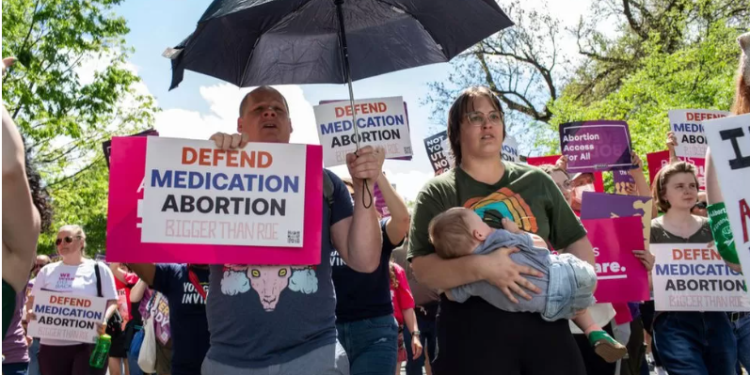A ruling that restricts access to an abortion pill throughout the United States will shortly go into effect unless the conservative-dominated Supreme Court steps in.
The Supreme Court struck down the national right to abortion last year, prompting more than a dozen states with Republican majorities to pass outright prohibitions.
The most recent effort by anti-abortion organisations aims to restrict access to the abortion medication mifepristone.
The pill is used in over fifty percent of abortions in the United States.
The Federal and Drug Administration (FDA) first approved it more than two decades ago.
Wednesday, the Supreme Court will determine the future of access to the pill in the United States. Here is how we got here:
What does the Supreme Court’s decision involve?
In 2000, when the FDA approved the drug in question, a federal magistrate in Texas ruled that the agency had not adequately considered the drug’s health effects. The case is currently being considered by the Supreme Court.
A federal magistrate in the state of Washington then issued a ruling in opposition, ordering the FDA to make no changes to the drug’s availability and preserving access to mifepristone in 17 U.S. states.
The Texas ruling was then sent to the 5th Circuit Court of Appeals in New Orleans, which ordered access restrictions to mifepristone but did not suspend its FDA approval as the Texas judge had ordered.
The United States Department of Justice and the drug’s manufacturer, Danco Laboratories, petitioned the Supreme Court to reverse the pill’s prohibition and restrictions.
Friday, US Supreme Court Justice Samuel Alito, who supervises emergency matters for the 5th Circuit, ordered a temporary halt to the restrictions while the court considers the future of the drug.
Could the availability of abortion medications shift?
Access to the abortion medication mifepristone throughout the United States will depend on the Supreme Court’s decision.
If the Supreme Court agrees with the 5th Circuit Court of Appeals or issues no ruling by Wednesday’s end, mifepristone will remain available, but access to it will be restricted immediately.
These conditions include requiring that the medication be taken in the presence of a physician, prohibiting patients from receiving the pill by mail, and reducing the use window from 10 to 7 weeks of pregnancy.
What implications does this have for other drugs?
Critics assert that the Texas court has usurped the FDA’s authority to regulate food, medicine, and medical devices by overriding its sanction.
The Food, Drug, and Cosmetic Act of 1938 grants the FDA the authority to determine whether medications are safe and effective, and courts have typically deferred to the agency’s scientific and medical judgements.
Experts in the law fear that the ruling could pave the way for challenges to other approved pharmaceuticals in the United States and impede the development of future medications.
I Professor of law at Harvard University Glenn Cohen told the BBC that the pharmaceutical industry may be wary of additional legal challenges, especially to treatments that have become political flashpoints in the United States, such as transgender health care and Covid-19 vaccines.
Mr. Cohen stated, “It’s conceivable in any space, but… it will trickle down and be the worst for drugs that are sometimes required by discrete and isolated minorities.”
What occurs next?
The Alliance Defending Freedom, a conservative Christian legal advocacy organisation that filed the initial lawsuit against the FDA, submitted a brief to the Supreme Court on Tuesday requesting that the restrictions on mifepristone be allowed to take effect.
147 Republican legislators have submitted their own brief to the court, calling the elimination of access restrictions to the drug “a dangerous game with the health and safety of women and girls.”
In opposition, a group of 253 Democratic legislators urged the Supreme Court to halt the original Texas ruling and allow mifepristone to remain on the market while the case progresses through the courts.
Democrats argued that the Texas decision would restrict abortion access nationwide.
Both briefs demonstrate that abortion remains a contentious issue in the United States. Now, all eyes will be on the Supreme Court to see what decision it makes.














































